Commercial Law Case Study: Contract Formation and Dispute Resolution
VerifiedAdded on 2023/06/15
|9
|2397
|280
Case Study
AI Summary
This commercial law case study examines contract formation issues arising from a Facebook marketplace transaction. It analyzes the legal positions of Alan, Bernard, Charleen, and Damien concerning the sale of a commercial law textbook and handwritten notes. The analysis focuses on key elements of contract law, including offer, acceptance, counteroffer, intention to create legal relations, and the principle that an offer can only be accepted by the party to whom it was made. The study concludes by discussing various alternative dispute resolution (ADR) methods such as mediation, neutral evaluation, and arbitration, providing insights into resolving commercial disputes outside of traditional litigation. Desklib provides a platform to access such solved assignments and past papers for students.
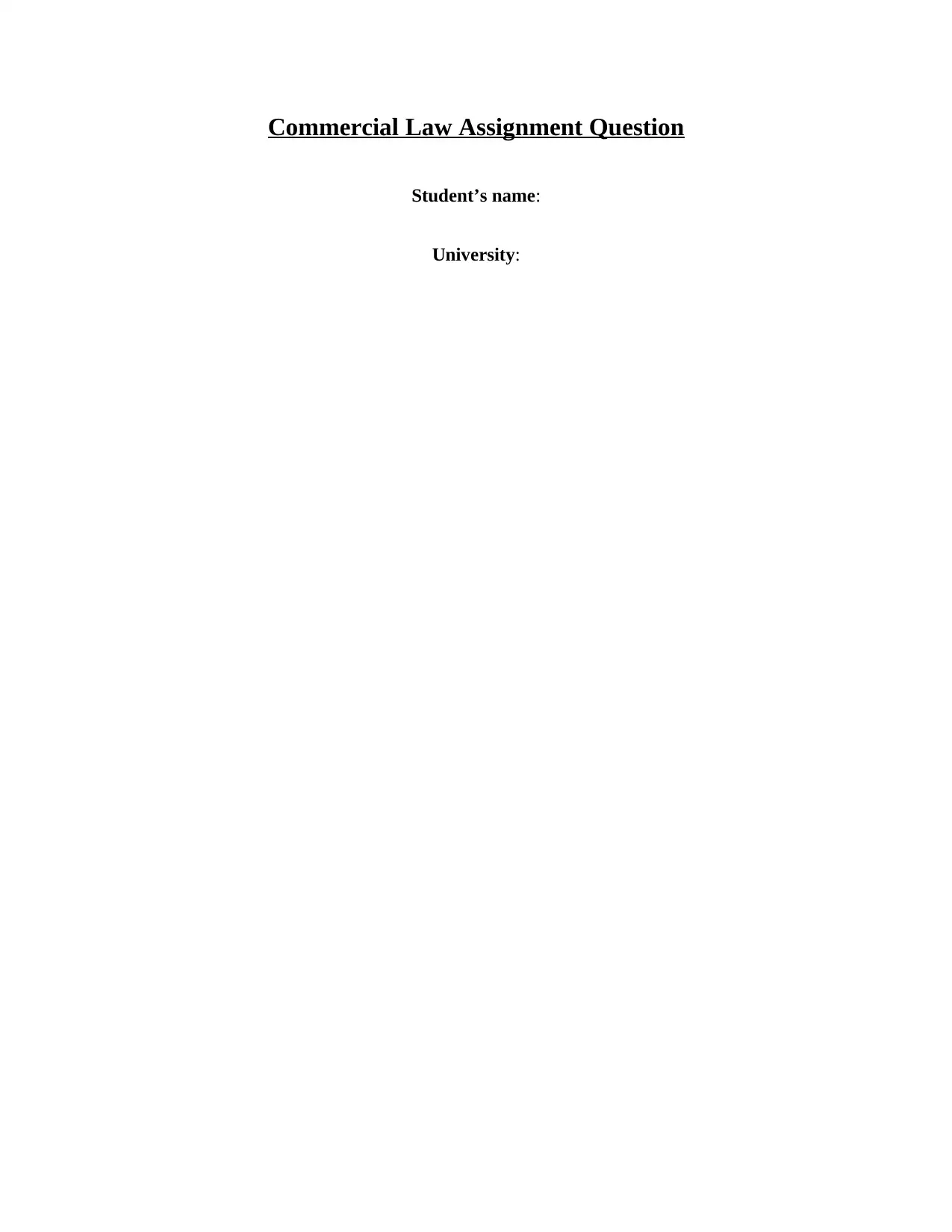
Commercial Law Assignment Question
Student’s name:
University:
Student’s name:
University:
Paraphrase This Document
Need a fresh take? Get an instant paraphrase of this document with our AI Paraphraser
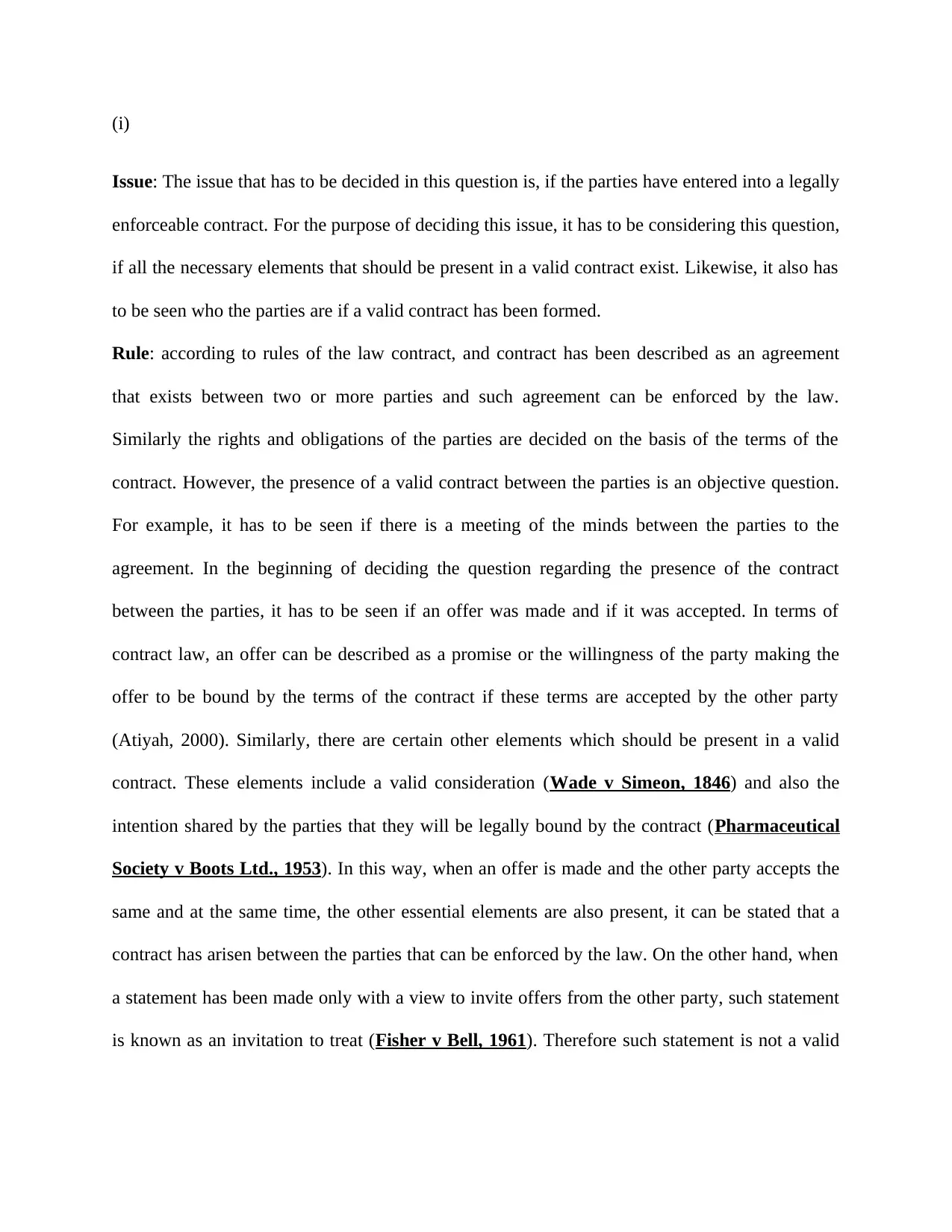
(i)
Issue: The issue that has to be decided in this question is, if the parties have entered into a legally
enforceable contract. For the purpose of deciding this issue, it has to be considering this question,
if all the necessary elements that should be present in a valid contract exist. Likewise, it also has
to be seen who the parties are if a valid contract has been formed.
Rule: according to rules of the law contract, and contract has been described as an agreement
that exists between two or more parties and such agreement can be enforced by the law.
Similarly the rights and obligations of the parties are decided on the basis of the terms of the
contract. However, the presence of a valid contract between the parties is an objective question.
For example, it has to be seen if there is a meeting of the minds between the parties to the
agreement. In the beginning of deciding the question regarding the presence of the contract
between the parties, it has to be seen if an offer was made and if it was accepted. In terms of
contract law, an offer can be described as a promise or the willingness of the party making the
offer to be bound by the terms of the contract if these terms are accepted by the other party
(Atiyah, 2000). Similarly, there are certain other elements which should be present in a valid
contract. These elements include a valid consideration (Wade v Simeon, 1846) and also the
intention shared by the parties that they will be legally bound by the contract (Pharmaceutical
Society v Boots Ltd., 1953). In this way, when an offer is made and the other party accepts the
same and at the same time, the other essential elements are also present, it can be stated that a
contract has arisen between the parties that can be enforced by the law. On the other hand, when
a statement has been made only with a view to invite offers from the other party, such statement
is known as an invitation to treat (Fisher v Bell, 1961). Therefore such statement is not a valid
Issue: The issue that has to be decided in this question is, if the parties have entered into a legally
enforceable contract. For the purpose of deciding this issue, it has to be considering this question,
if all the necessary elements that should be present in a valid contract exist. Likewise, it also has
to be seen who the parties are if a valid contract has been formed.
Rule: according to rules of the law contract, and contract has been described as an agreement
that exists between two or more parties and such agreement can be enforced by the law.
Similarly the rights and obligations of the parties are decided on the basis of the terms of the
contract. However, the presence of a valid contract between the parties is an objective question.
For example, it has to be seen if there is a meeting of the minds between the parties to the
agreement. In the beginning of deciding the question regarding the presence of the contract
between the parties, it has to be seen if an offer was made and if it was accepted. In terms of
contract law, an offer can be described as a promise or the willingness of the party making the
offer to be bound by the terms of the contract if these terms are accepted by the other party
(Atiyah, 2000). Similarly, there are certain other elements which should be present in a valid
contract. These elements include a valid consideration (Wade v Simeon, 1846) and also the
intention shared by the parties that they will be legally bound by the contract (Pharmaceutical
Society v Boots Ltd., 1953). In this way, when an offer is made and the other party accepts the
same and at the same time, the other essential elements are also present, it can be stated that a
contract has arisen between the parties that can be enforced by the law. On the other hand, when
a statement has been made only with a view to invite offers from the other party, such statement
is known as an invitation to treat (Fisher v Bell, 1961). Therefore such statement is not a valid
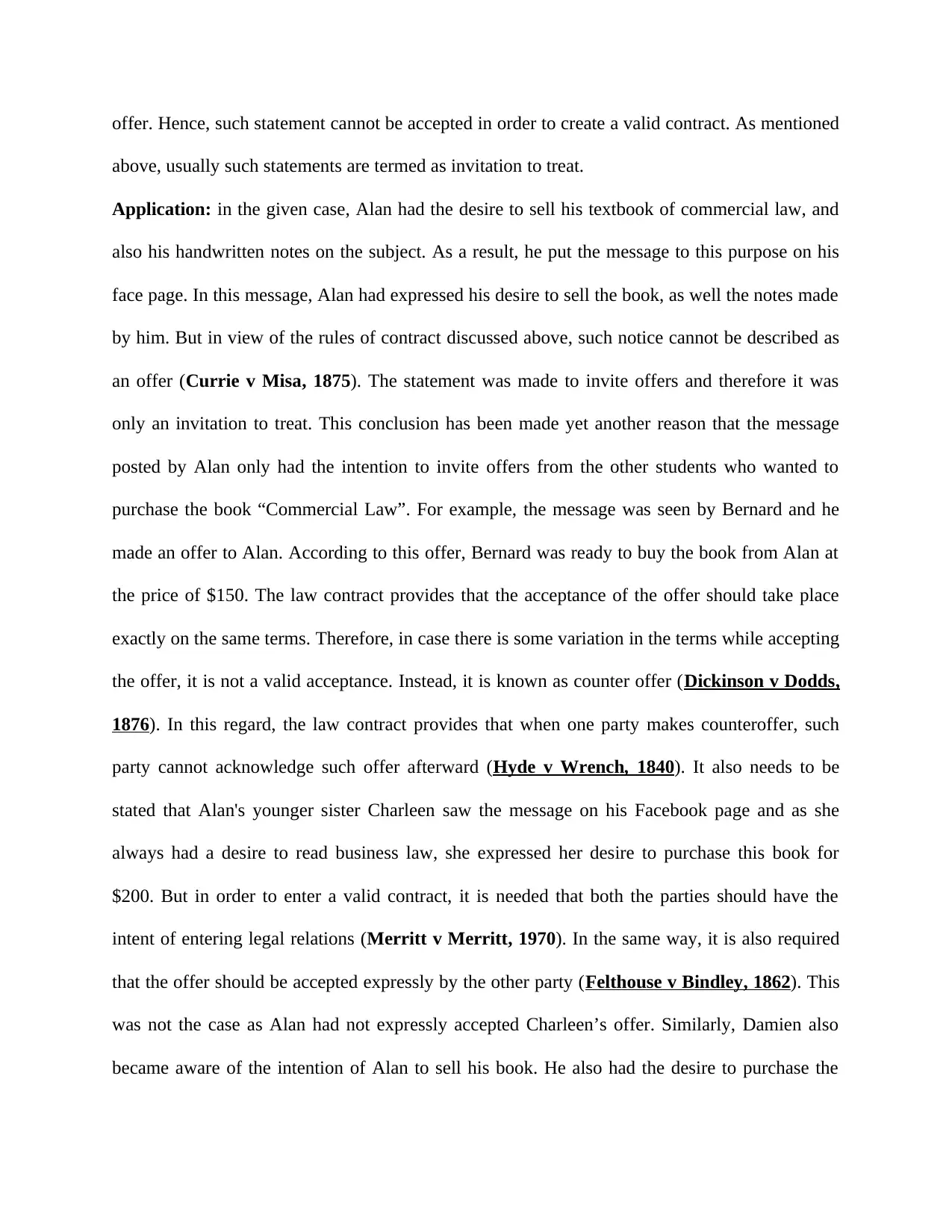
offer. Hence, such statement cannot be accepted in order to create a valid contract. As mentioned
above, usually such statements are termed as invitation to treat.
Application: in the given case, Alan had the desire to sell his textbook of commercial law, and
also his handwritten notes on the subject. As a result, he put the message to this purpose on his
face page. In this message, Alan had expressed his desire to sell the book, as well the notes made
by him. But in view of the rules of contract discussed above, such notice cannot be described as
an offer (Currie v Misa, 1875). The statement was made to invite offers and therefore it was
only an invitation to treat. This conclusion has been made yet another reason that the message
posted by Alan only had the intention to invite offers from the other students who wanted to
purchase the book “Commercial Law”. For example, the message was seen by Bernard and he
made an offer to Alan. According to this offer, Bernard was ready to buy the book from Alan at
the price of $150. The law contract provides that the acceptance of the offer should take place
exactly on the same terms. Therefore, in case there is some variation in the terms while accepting
the offer, it is not a valid acceptance. Instead, it is known as counter offer (Dickinson v Dodds,
1876). In this regard, the law contract provides that when one party makes counteroffer, such
party cannot acknowledge such offer afterward (Hyde v Wrench, 1840). It also needs to be
stated that Alan's younger sister Charleen saw the message on his Facebook page and as she
always had a desire to read business law, she expressed her desire to purchase this book for
$200. But in order to enter a valid contract, it is needed that both the parties should have the
intent of entering legal relations (Merritt v Merritt, 1970). In the same way, it is also required
that the offer should be accepted expressly by the other party (Felthouse v Bindley, 1862). This
was not the case as Alan had not expressly accepted Charleen’s offer. Similarly, Damien also
became aware of the intention of Alan to sell his book. He also had the desire to purchase the
above, usually such statements are termed as invitation to treat.
Application: in the given case, Alan had the desire to sell his textbook of commercial law, and
also his handwritten notes on the subject. As a result, he put the message to this purpose on his
face page. In this message, Alan had expressed his desire to sell the book, as well the notes made
by him. But in view of the rules of contract discussed above, such notice cannot be described as
an offer (Currie v Misa, 1875). The statement was made to invite offers and therefore it was
only an invitation to treat. This conclusion has been made yet another reason that the message
posted by Alan only had the intention to invite offers from the other students who wanted to
purchase the book “Commercial Law”. For example, the message was seen by Bernard and he
made an offer to Alan. According to this offer, Bernard was ready to buy the book from Alan at
the price of $150. The law contract provides that the acceptance of the offer should take place
exactly on the same terms. Therefore, in case there is some variation in the terms while accepting
the offer, it is not a valid acceptance. Instead, it is known as counter offer (Dickinson v Dodds,
1876). In this regard, the law contract provides that when one party makes counteroffer, such
party cannot acknowledge such offer afterward (Hyde v Wrench, 1840). It also needs to be
stated that Alan's younger sister Charleen saw the message on his Facebook page and as she
always had a desire to read business law, she expressed her desire to purchase this book for
$200. But in order to enter a valid contract, it is needed that both the parties should have the
intent of entering legal relations (Merritt v Merritt, 1970). In the same way, it is also required
that the offer should be accepted expressly by the other party (Felthouse v Bindley, 1862). This
was not the case as Alan had not expressly accepted Charleen’s offer. Similarly, Damien also
became aware of the intention of Alan to sell his book. He also had the desire to purchase the
⊘ This is a preview!⊘
Do you want full access?
Subscribe today to unlock all pages.

Trusted by 1+ million students worldwide
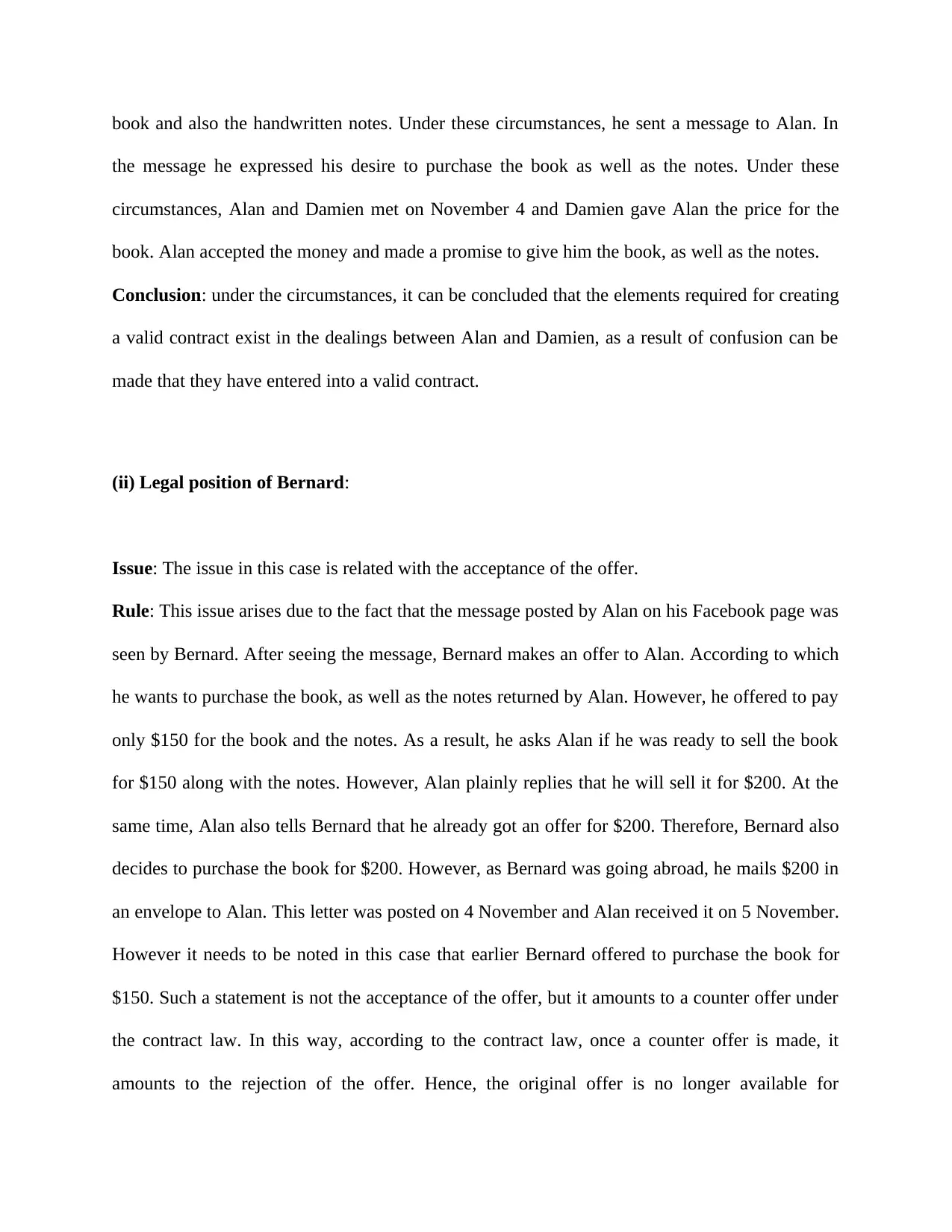
book and also the handwritten notes. Under these circumstances, he sent a message to Alan. In
the message he expressed his desire to purchase the book as well as the notes. Under these
circumstances, Alan and Damien met on November 4 and Damien gave Alan the price for the
book. Alan accepted the money and made a promise to give him the book, as well as the notes.
Conclusion: under the circumstances, it can be concluded that the elements required for creating
a valid contract exist in the dealings between Alan and Damien, as a result of confusion can be
made that they have entered into a valid contract.
(ii) Legal position of Bernard:
Issue: The issue in this case is related with the acceptance of the offer.
Rule: This issue arises due to the fact that the message posted by Alan on his Facebook page was
seen by Bernard. After seeing the message, Bernard makes an offer to Alan. According to which
he wants to purchase the book, as well as the notes returned by Alan. However, he offered to pay
only $150 for the book and the notes. As a result, he asks Alan if he was ready to sell the book
for $150 along with the notes. However, Alan plainly replies that he will sell it for $200. At the
same time, Alan also tells Bernard that he already got an offer for $200. Therefore, Bernard also
decides to purchase the book for $200. However, as Bernard was going abroad, he mails $200 in
an envelope to Alan. This letter was posted on 4 November and Alan received it on 5 November.
However it needs to be noted in this case that earlier Bernard offered to purchase the book for
$150. Such a statement is not the acceptance of the offer, but it amounts to a counter offer under
the contract law. In this way, according to the contract law, once a counter offer is made, it
amounts to the rejection of the offer. Hence, the original offer is no longer available for
the message he expressed his desire to purchase the book as well as the notes. Under these
circumstances, Alan and Damien met on November 4 and Damien gave Alan the price for the
book. Alan accepted the money and made a promise to give him the book, as well as the notes.
Conclusion: under the circumstances, it can be concluded that the elements required for creating
a valid contract exist in the dealings between Alan and Damien, as a result of confusion can be
made that they have entered into a valid contract.
(ii) Legal position of Bernard:
Issue: The issue in this case is related with the acceptance of the offer.
Rule: This issue arises due to the fact that the message posted by Alan on his Facebook page was
seen by Bernard. After seeing the message, Bernard makes an offer to Alan. According to which
he wants to purchase the book, as well as the notes returned by Alan. However, he offered to pay
only $150 for the book and the notes. As a result, he asks Alan if he was ready to sell the book
for $150 along with the notes. However, Alan plainly replies that he will sell it for $200. At the
same time, Alan also tells Bernard that he already got an offer for $200. Therefore, Bernard also
decides to purchase the book for $200. However, as Bernard was going abroad, he mails $200 in
an envelope to Alan. This letter was posted on 4 November and Alan received it on 5 November.
However it needs to be noted in this case that earlier Bernard offered to purchase the book for
$150. Such a statement is not the acceptance of the offer, but it amounts to a counter offer under
the contract law. In this way, according to the contract law, once a counter offer is made, it
amounts to the rejection of the offer. Hence, the original offer is no longer available for
Paraphrase This Document
Need a fresh take? Get an instant paraphrase of this document with our AI Paraphraser
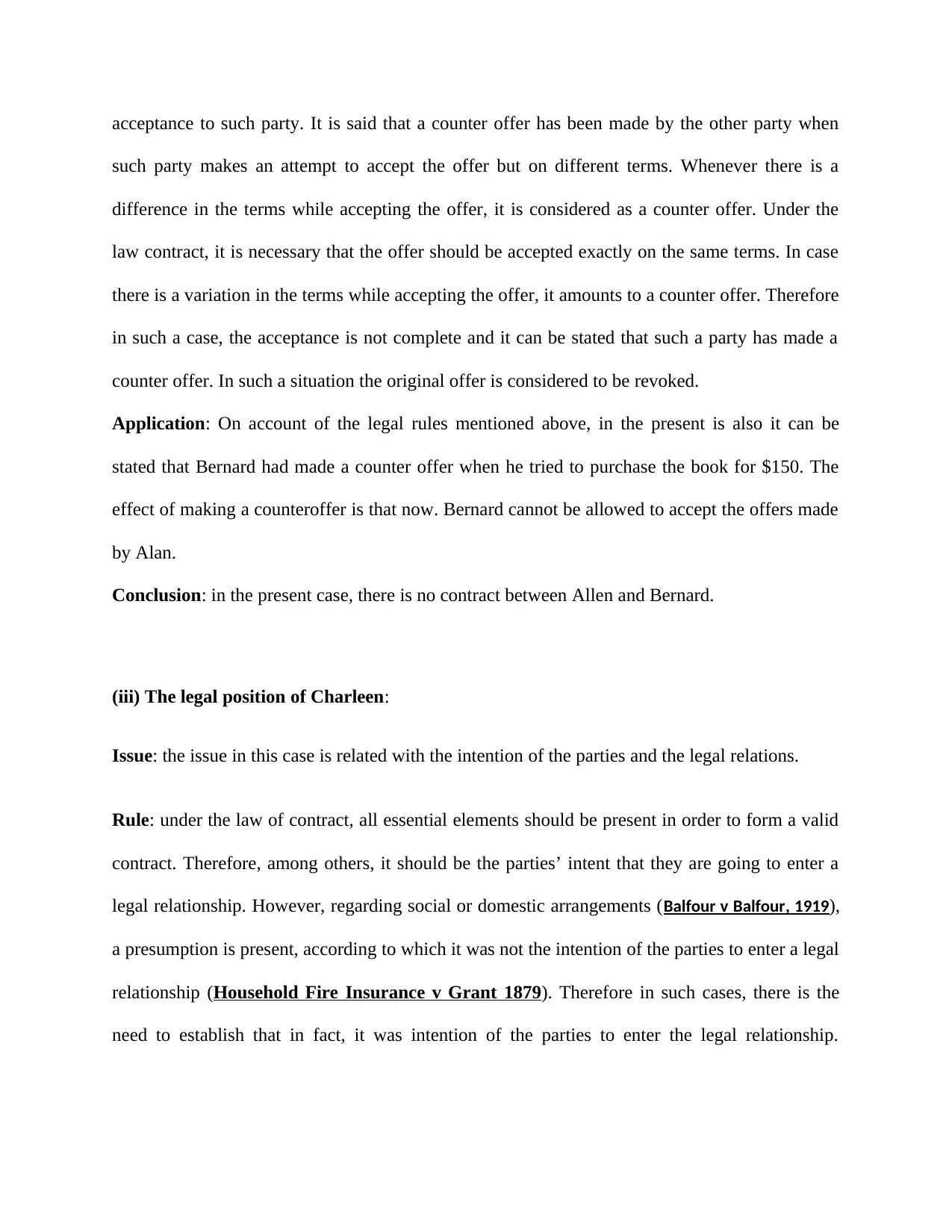
acceptance to such party. It is said that a counter offer has been made by the other party when
such party makes an attempt to accept the offer but on different terms. Whenever there is a
difference in the terms while accepting the offer, it is considered as a counter offer. Under the
law contract, it is necessary that the offer should be accepted exactly on the same terms. In case
there is a variation in the terms while accepting the offer, it amounts to a counter offer. Therefore
in such a case, the acceptance is not complete and it can be stated that such a party has made a
counter offer. In such a situation the original offer is considered to be revoked.
Application: On account of the legal rules mentioned above, in the present is also it can be
stated that Bernard had made a counter offer when he tried to purchase the book for $150. The
effect of making a counteroffer is that now. Bernard cannot be allowed to accept the offers made
by Alan.
Conclusion: in the present case, there is no contract between Allen and Bernard.
(iii) The legal position of Charleen:
Issue: the issue in this case is related with the intention of the parties and the legal relations.
Rule: under the law of contract, all essential elements should be present in order to form a valid
contract. Therefore, among others, it should be the parties’ intent that they are going to enter a
legal relationship. However, regarding social or domestic arrangements (Balfour v Balfour, 1919),
a presumption is present, according to which it was not the intention of the parties to enter a legal
relationship (Household Fire Insurance v Grant 1879). Therefore in such cases, there is the
need to establish that in fact, it was intention of the parties to enter the legal relationship.
such party makes an attempt to accept the offer but on different terms. Whenever there is a
difference in the terms while accepting the offer, it is considered as a counter offer. Under the
law contract, it is necessary that the offer should be accepted exactly on the same terms. In case
there is a variation in the terms while accepting the offer, it amounts to a counter offer. Therefore
in such a case, the acceptance is not complete and it can be stated that such a party has made a
counter offer. In such a situation the original offer is considered to be revoked.
Application: On account of the legal rules mentioned above, in the present is also it can be
stated that Bernard had made a counter offer when he tried to purchase the book for $150. The
effect of making a counteroffer is that now. Bernard cannot be allowed to accept the offers made
by Alan.
Conclusion: in the present case, there is no contract between Allen and Bernard.
(iii) The legal position of Charleen:
Issue: the issue in this case is related with the intention of the parties and the legal relations.
Rule: under the law of contract, all essential elements should be present in order to form a valid
contract. Therefore, among others, it should be the parties’ intent that they are going to enter a
legal relationship. However, regarding social or domestic arrangements (Balfour v Balfour, 1919),
a presumption is present, according to which it was not the intention of the parties to enter a legal
relationship (Household Fire Insurance v Grant 1879). Therefore in such cases, there is the
need to establish that in fact, it was intention of the parties to enter the legal relationship.
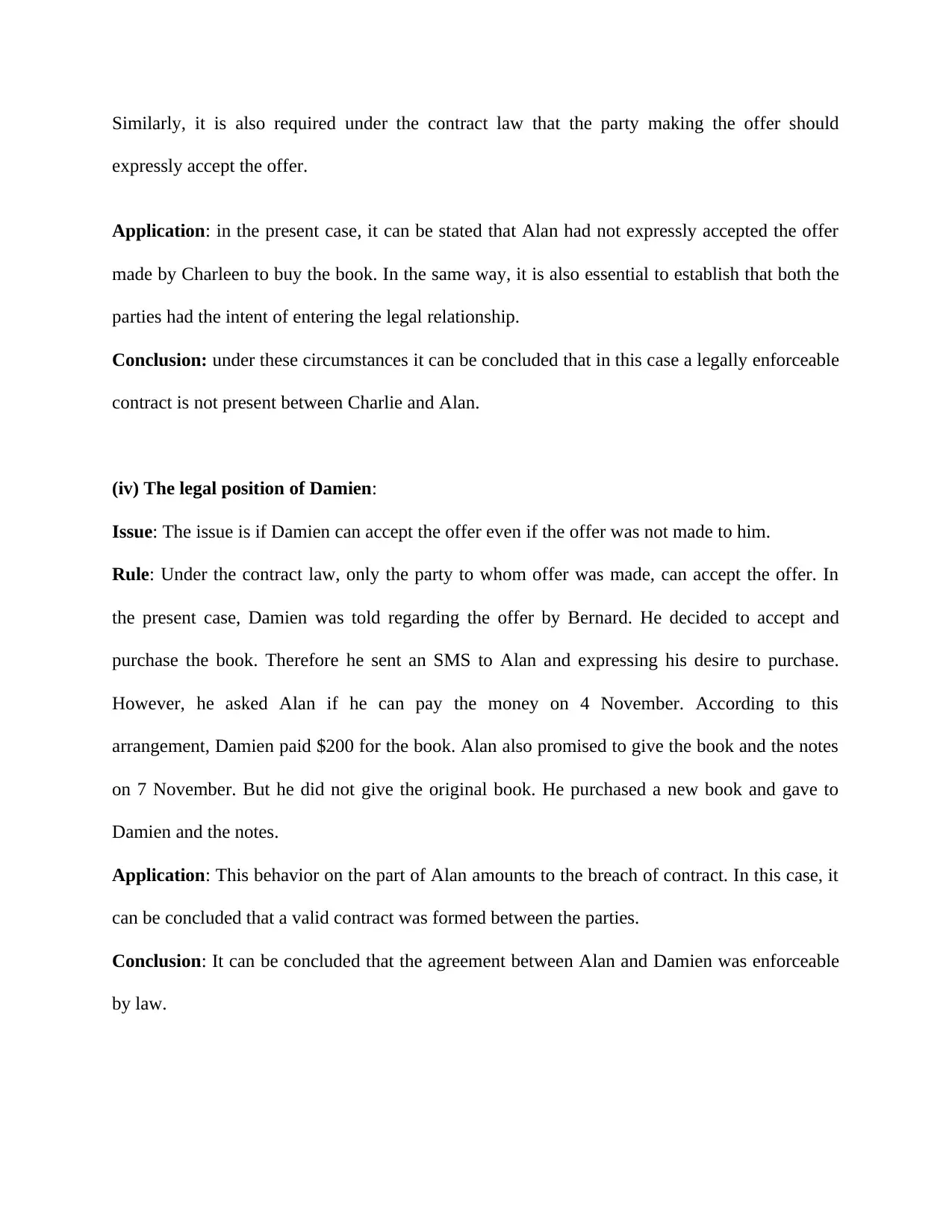
Similarly, it is also required under the contract law that the party making the offer should
expressly accept the offer.
Application: in the present case, it can be stated that Alan had not expressly accepted the offer
made by Charleen to buy the book. In the same way, it is also essential to establish that both the
parties had the intent of entering the legal relationship.
Conclusion: under these circumstances it can be concluded that in this case a legally enforceable
contract is not present between Charlie and Alan.
(iv) The legal position of Damien:
Issue: The issue is if Damien can accept the offer even if the offer was not made to him.
Rule: Under the contract law, only the party to whom offer was made, can accept the offer. In
the present case, Damien was told regarding the offer by Bernard. He decided to accept and
purchase the book. Therefore he sent an SMS to Alan and expressing his desire to purchase.
However, he asked Alan if he can pay the money on 4 November. According to this
arrangement, Damien paid $200 for the book. Alan also promised to give the book and the notes
on 7 November. But he did not give the original book. He purchased a new book and gave to
Damien and the notes.
Application: This behavior on the part of Alan amounts to the breach of contract. In this case, it
can be concluded that a valid contract was formed between the parties.
Conclusion: It can be concluded that the agreement between Alan and Damien was enforceable
by law.
expressly accept the offer.
Application: in the present case, it can be stated that Alan had not expressly accepted the offer
made by Charleen to buy the book. In the same way, it is also essential to establish that both the
parties had the intent of entering the legal relationship.
Conclusion: under these circumstances it can be concluded that in this case a legally enforceable
contract is not present between Charlie and Alan.
(iv) The legal position of Damien:
Issue: The issue is if Damien can accept the offer even if the offer was not made to him.
Rule: Under the contract law, only the party to whom offer was made, can accept the offer. In
the present case, Damien was told regarding the offer by Bernard. He decided to accept and
purchase the book. Therefore he sent an SMS to Alan and expressing his desire to purchase.
However, he asked Alan if he can pay the money on 4 November. According to this
arrangement, Damien paid $200 for the book. Alan also promised to give the book and the notes
on 7 November. But he did not give the original book. He purchased a new book and gave to
Damien and the notes.
Application: This behavior on the part of Alan amounts to the breach of contract. In this case, it
can be concluded that a valid contract was formed between the parties.
Conclusion: It can be concluded that the agreement between Alan and Damien was enforceable
by law.
⊘ This is a preview!⊘
Do you want full access?
Subscribe today to unlock all pages.

Trusted by 1+ million students worldwide
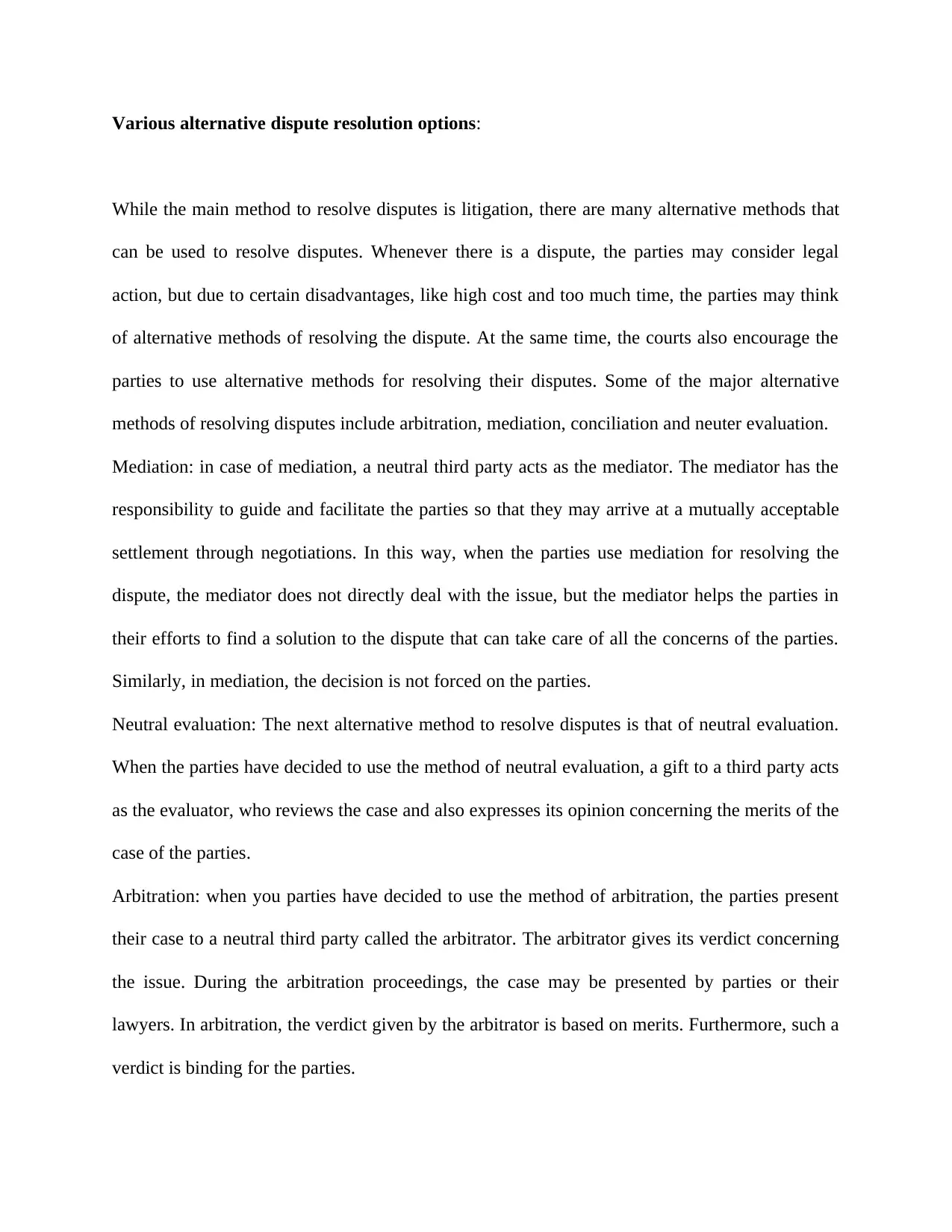
Various alternative dispute resolution options:
While the main method to resolve disputes is litigation, there are many alternative methods that
can be used to resolve disputes. Whenever there is a dispute, the parties may consider legal
action, but due to certain disadvantages, like high cost and too much time, the parties may think
of alternative methods of resolving the dispute. At the same time, the courts also encourage the
parties to use alternative methods for resolving their disputes. Some of the major alternative
methods of resolving disputes include arbitration, mediation, conciliation and neuter evaluation.
Mediation: in case of mediation, a neutral third party acts as the mediator. The mediator has the
responsibility to guide and facilitate the parties so that they may arrive at a mutually acceptable
settlement through negotiations. In this way, when the parties use mediation for resolving the
dispute, the mediator does not directly deal with the issue, but the mediator helps the parties in
their efforts to find a solution to the dispute that can take care of all the concerns of the parties.
Similarly, in mediation, the decision is not forced on the parties.
Neutral evaluation: The next alternative method to resolve disputes is that of neutral evaluation.
When the parties have decided to use the method of neutral evaluation, a gift to a third party acts
as the evaluator, who reviews the case and also expresses its opinion concerning the merits of the
case of the parties.
Arbitration: when you parties have decided to use the method of arbitration, the parties present
their case to a neutral third party called the arbitrator. The arbitrator gives its verdict concerning
the issue. During the arbitration proceedings, the case may be presented by parties or their
lawyers. In arbitration, the verdict given by the arbitrator is based on merits. Furthermore, such a
verdict is binding for the parties.
While the main method to resolve disputes is litigation, there are many alternative methods that
can be used to resolve disputes. Whenever there is a dispute, the parties may consider legal
action, but due to certain disadvantages, like high cost and too much time, the parties may think
of alternative methods of resolving the dispute. At the same time, the courts also encourage the
parties to use alternative methods for resolving their disputes. Some of the major alternative
methods of resolving disputes include arbitration, mediation, conciliation and neuter evaluation.
Mediation: in case of mediation, a neutral third party acts as the mediator. The mediator has the
responsibility to guide and facilitate the parties so that they may arrive at a mutually acceptable
settlement through negotiations. In this way, when the parties use mediation for resolving the
dispute, the mediator does not directly deal with the issue, but the mediator helps the parties in
their efforts to find a solution to the dispute that can take care of all the concerns of the parties.
Similarly, in mediation, the decision is not forced on the parties.
Neutral evaluation: The next alternative method to resolve disputes is that of neutral evaluation.
When the parties have decided to use the method of neutral evaluation, a gift to a third party acts
as the evaluator, who reviews the case and also expresses its opinion concerning the merits of the
case of the parties.
Arbitration: when you parties have decided to use the method of arbitration, the parties present
their case to a neutral third party called the arbitrator. The arbitrator gives its verdict concerning
the issue. During the arbitration proceedings, the case may be presented by parties or their
lawyers. In arbitration, the verdict given by the arbitrator is based on merits. Furthermore, such a
verdict is binding for the parties.
Paraphrase This Document
Need a fresh take? Get an instant paraphrase of this document with our AI Paraphraser

Hence, the parties can use the methods discussed above in order to resolve their disputes instead
of taking legal action.
of taking legal action.
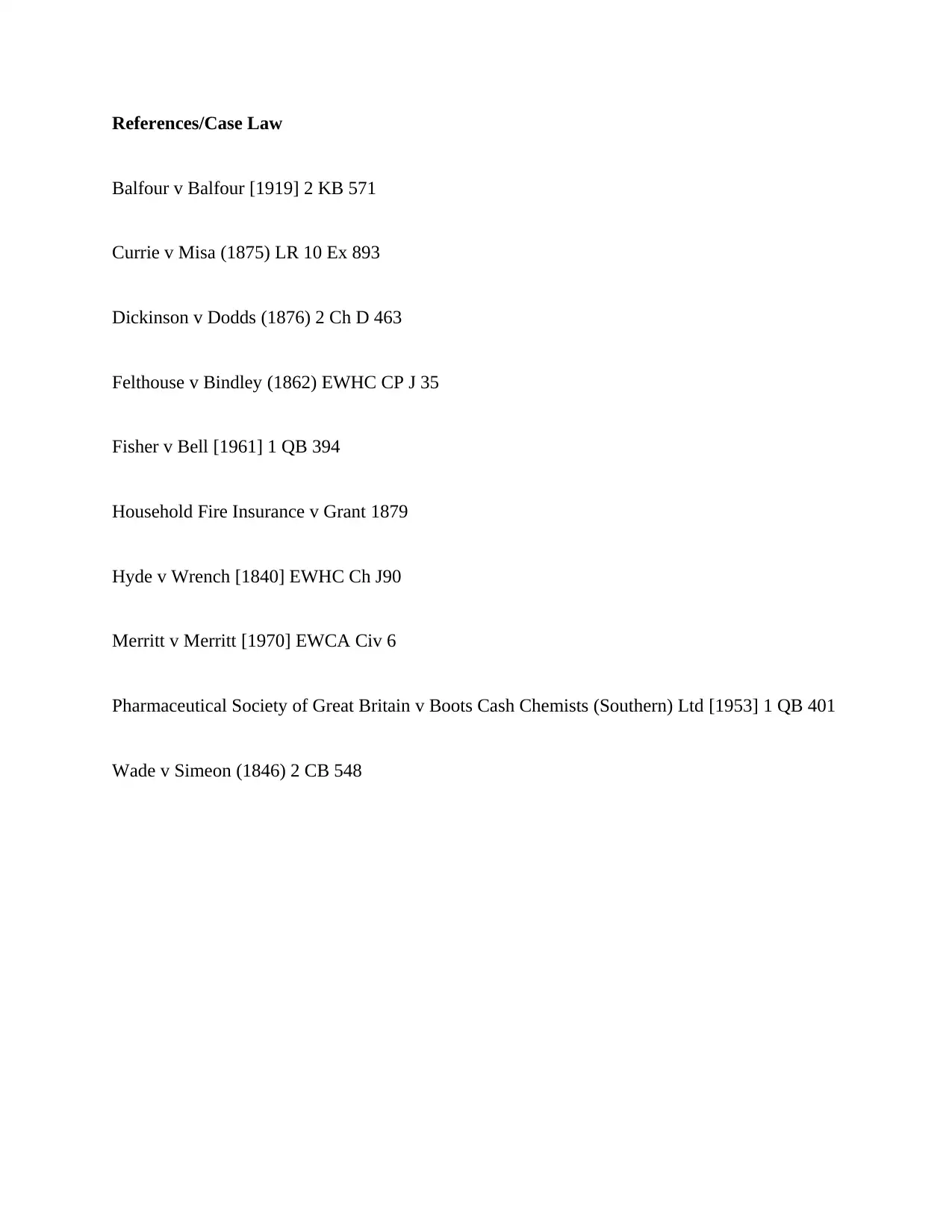
References/Case Law
Balfour v Balfour [1919] 2 KB 571
Currie v Misa (1875) LR 10 Ex 893
Dickinson v Dodds (1876) 2 Ch D 463
Felthouse v Bindley (1862) EWHC CP J 35
Fisher v Bell [1961] 1 QB 394
Household Fire Insurance v Grant 1879
Hyde v Wrench [1840] EWHC Ch J90
Merritt v Merritt [1970] EWCA Civ 6
Pharmaceutical Society of Great Britain v Boots Cash Chemists (Southern) Ltd [1953] 1 QB 401
Wade v Simeon (1846) 2 CB 548
Balfour v Balfour [1919] 2 KB 571
Currie v Misa (1875) LR 10 Ex 893
Dickinson v Dodds (1876) 2 Ch D 463
Felthouse v Bindley (1862) EWHC CP J 35
Fisher v Bell [1961] 1 QB 394
Household Fire Insurance v Grant 1879
Hyde v Wrench [1840] EWHC Ch J90
Merritt v Merritt [1970] EWCA Civ 6
Pharmaceutical Society of Great Britain v Boots Cash Chemists (Southern) Ltd [1953] 1 QB 401
Wade v Simeon (1846) 2 CB 548
⊘ This is a preview!⊘
Do you want full access?
Subscribe today to unlock all pages.

Trusted by 1+ million students worldwide
1 out of 9
Related Documents
Your All-in-One AI-Powered Toolkit for Academic Success.
+13062052269
info@desklib.com
Available 24*7 on WhatsApp / Email
![[object Object]](/_next/static/media/star-bottom.7253800d.svg)
Unlock your academic potential
Copyright © 2020–2025 A2Z Services. All Rights Reserved. Developed and managed by ZUCOL.





